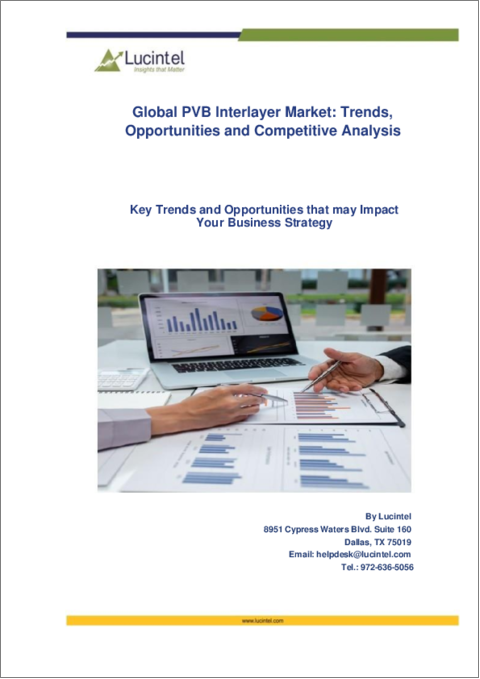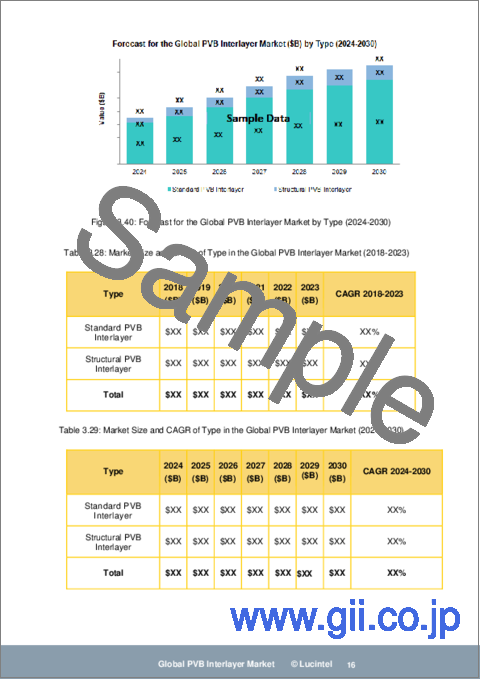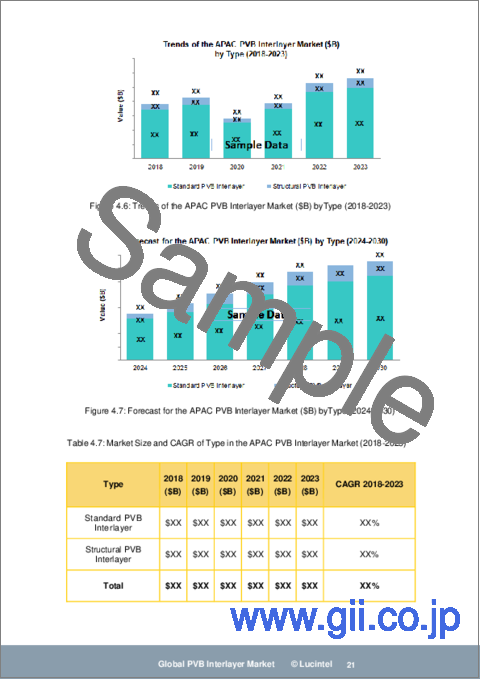|
|
市場調査レポート
商品コード
1297919
PVB中間膜市場:動向、機会、競合分析【2023-2028年】PVB Interlayer Market: Trends, Opportunities and Competitive Analysis [2023-2028] |
||||||
カスタマイズ可能
適宜更新あり
|
|||||||
| PVB中間膜市場:動向、機会、競合分析【2023-2028年】 |
|
出版日: 2023年06月01日
発行: Lucintel
ページ情報: 英文 150 Pages
納期: 3営業日
|
- 全表示
- 概要
- 目次
PVB中間膜市場の動向と予測
PVB中間膜の世界市場は、2023年から2028年までのCAGRが7.0%で、2028年までに推定58億6,000万米ドルに達すると予測されます。この市場の主な促進要因は、自動車生産の増加、厳格なガラス安全規制の導入、世界の再生可能エネルギー発電需要の拡大です。世界のPVB中間膜市場の将来は、自動車、建築・建設、太陽光発電の最終用途産業におけるビジネスチャンスによって有望視されています。
PVB中間膜企業リスト
PVB中間膜市場の企業は、提供する製品の品質で競争しています。この市場の主要企業は、製造施設の拡大、研究開発投資、インフラ開拓、バリューチェーン全体にわたる統合機会の活用に注力しています。これらの戦略により、PVB中間膜企業は需要の増加に対応し、競争力を確保し、革新的な製品と技術を開発し、生産コストを削減し、顧客基盤を拡大しています。
PVB中間膜市場の洞察
- Lucintelの予測では、標準的PVB中間膜は安全性とセキュリティ性能が高いため、様々な合わせガラス用途の70%以上に使用されており、予測期間中も大きな市場規模を維持すると思われます。標準的PVB中間膜はガラスの防音性能とUVカット性能も向上させます。
- PVB中間膜はPVモジュールに使用され、他のプラスチック中間膜よりも優れているため、太陽光発電産業が最も高い成長を維持すると予想されます。
- APACは、中国、インド、日本、韓国などの国々で電気自動車の生産が増加し、建築・建設プロジェクトが増加しているため、予測期間中最大の地域であり続けると思われます。
本レポートでは、以下の11の主要な質問に回答している:
- Q.1.市場セグメントのうち、最も有望かつ高成長な機会は何か?
- Q.2.どのセグメントがより速いペースで成長するのか、またその理由は?
- Q.3.今後成長が加速すると思われる地域とその理由は?
- Q.4.市場力学に影響を与える主な要因は何か?市場における主な課題とビジネスリスクは?
- Q.5.この市場におけるビジネスリスクと競合の脅威は?
- Q.6.この市場における新たな動向とその理由は?
- Q.7.市場における顧客の需要の変化にはどのようなものがありますか?
- Q.8.この市場における新たな開発と、その開発をリードしている企業は?
- Q.9.市場の主要企業は?主要企業は事業成長のためにどのような戦略的取り組みを進めていますか?
- Q.10.この市場における競合製品にはどのようなものがあり、材料や製品の代替による市場シェア低下の脅威はどの程度ありますか?
- Q.11.過去5年間にどのようなM&Aが行われ、業界にどのような影響を与えましたか?
目次
第1章 エグゼクティブサマリー
第2章 世界のPVB中間膜市場:市場力学
- イントロダクション、背景、分類
- サプライチェーン
- 業界の推進力と課題
第3章 2017年から2028年までの市場動向と予測分析
- マクロ経済動向(2017~2022年)と予測(2023~2028年)
- 世界のPVB中間膜市場動向(2017~2022年)と予測(2023~2028年)
- タイプ別の世界のPVB中間膜市場
- 標準的PVB中間膜
- 構造的PVB中間膜
- 最終用途産業別の世界のPVB中間膜市場
- 自動車
- 建築・建設
- 太陽光発電
第4章 2017年から2028年までの地域別の市場動向と予測分析
- 地域別のPVB中間膜市場
- 北米のPVB中間膜市場
- 欧州のPVB中間膜市場
- アジア太平洋のPVB中間膜市場
- その他地域のPVB中間膜市場
第5章 競合の分析
- 製品ポートフォリオ分析
- 運用上の統合
- ポーターのファイブフォース分析
第6章 成長機会と戦略分析
- 成長機会分析
- タイプ別の世界のPVB中間膜市場の成長機会
- 最終用途産業別の世界のPVB中間膜市場の成長機会
- 地域別の世界のPVB中間膜市場の成長機会
- 世界のPVB中間膜市場の新たな動向
- 戦略的分析
- 新製品の開発
- 世界のPVB中間膜市場の生産能力拡大
- 世界のPVB中間膜市場における合併、買収、合弁事業
- 認証とライセンシング
第7章 有力企業の企業プロファイル
- Eastman Chemical Company
- Kuraray
- Sekisui Chemicals
- Huakai Plastic
- Everlam
- Genau Manufacturing Company
- KB PVB
- Chang Chun Group
PVB Interlayer Market Trends and Forecast
The future of the global PVB interlayer market looks promising with opportunities in the automotive, building & construction, and photovoltaic end use industries. The global PVB interlayer market is expected to reach an estimated $5.86 billion by 2028 with a CAGR of 7.0% from 2023 to 2028. The major drivers for this market are increasing automotive production, introduction of stringent glass safety regulations, and growing demand for renewable sources for energy generation, globally.
A more than 150-page report is developed to help in your business decisions.
PVB Interlayer Market by Segment
The study includes trends and forecast for the global PVB interlayer market by type, end use industry, and region, as follows:
PVB Interlayer Market by Type [Value ($B) Shipment Analysis from 2017 to 2028]:
- Standard PVB Interlayer
- Structural PVB Interlayer
PVB Interlayer Market by End Use Industry [Value ($B) Shipment Analysis from 2017 to 2028]:
- Automotive
- Building & Construction
- Photovoltaic
PVB Interlayer Market by Region [Value ($B) Shipment Analysis from 2017 to 2028]:
- North America
- Europe
- Asia Pacific
- The Rest of the World
List of PVB Interlayer Companies
Companies in the market compete on the basis of product quality offered. Major players in this market focus on expanding their manufacturing facilities, R&D investments, infrastructural development, and leverage integration opportunities across the value chain. With these strategies, PVB interlayer companies cater to increasing demand, ensure competitive effectiveness, develop innovative products & technologies, reduce production costs, and expand their customer base. Some of the PVB interlayer companies profiled in this report include:
- Eastman Chemical Company
- Kuraray
- Sekisui Chemicals
- Huakai Plastic
- Everlam
- Genau Manufacturing Company
- KB PVB
- Chang Chun Group
PVB Interlayer Market Insights
- Lucintel forecasts that standard PVB interlayer will remain the larger type segment over the forecast period because it is used in more than 70% of various laminated glass applications owing to its enhanced safety and security performance. Standard PVB interlayer also ensures improvement in the acoustic and UV protection performance of glass.
- Within this market, photovoltaic is expected to remain the end use industry segment with the highest growth because it provides benefits over other plastic materials encapsulating in the photovoltaic modules.
- APAC will remain the largest region during the forecast period due to increasing production of electric vehicles and growing number of building & construction projects in countries, such as China, India, Japan, and South Korea, in the region.
Features of the PVB Interlayer Market
- Market Size Estimates: PVB interlayer market size estimation in terms of value ($B)
- Trend and Forecast Analysis: Market trends (2017-2022) and forecast (2023-2028) by various segments and regions.
- Segmentation Analysis: PVB interlayer market size by various segments, such as by type, end use industry, and region
- Regional Analysis: PVB interlayer market breakdown by North America, Europe, Asia Pacific, and the Rest of the World.
- Growth Opportunities: Analysis on growth opportunities in different types, end use industries, and regions for the PVB interlayer market.
- Strategic Analysis: This includes M&A, new product development, and competitive landscape for the PVB interlayer market.
- Analysis of competitive intensity of the industry based on Porter's Five Forces model.
FAQ
- Q1. What is the PVB interlayer market size?
- Answer: The global PVB interlayer market is expected to reach an estimated $5.86 billion by 2028.
- Q2. What is the growth forecast for PVB interlayer market?
- Answer: The global PVB interlayer market is expected to grow with a CAGR of 7.0% from 2023 to 2028.
- Q3. What are the major drivers influencing the growth of the PVB interlayer market?
- Answer: The major drivers for this market are increasing automotive production, introduction of stringent glass safety regulations, and growing demand for renewable sources for energy generation, globally.
- Q4. What are the major segments for PVB interlayer market?
- Answer: The future of the global PVB interlayer market looks promising with opportunities in the automotive, building & construction, and photovoltaic end use industries.
- Q5. Who are the key PVB interlayer companies?
- Answer: Some of the key PVB interlayer companies are as follows:
- Eastman Chemical Company
- Kuraray
- Sekisui Chemicals
- Huakai Plastic
- Everlam
- Genau Manufacturing Company
- KB PVB
- Chang Chun Group
- Q6. Which PVB interlayer segment will be the largest in future?
- Answer:Lucintel forecasts that standard PVB interlayer will remain the larger type segment over the forecast period because it is used in more than 70% of various laminated glass applications owing to its enhanced safety and security performance and ensures improvement in the acoustic and UV protection performance of glass.
- Q7. In PVB interlayer market, which region is expected to be the largest in next 5 years?
- Answer: APAC will remain the largest region during the forecast period due to increasing production of electric vehicles and growing number of building & construction projects in countries, such as China, India, Japan, and South Korea, in the region.
- Q8. Do we receive customization in this report?
- Answer: Yes, Lucintel provides 10% Customization Without any Additional Cost.
This report answers following 11 key questions:
- Q.1. What are some of the most promising, high-growth opportunities for the global PVB interlayer market by type (standard PVB interlayer and structural PVB interlayer), end use industry (automotive, building & construction, and photovoltaic), and region (North America, Europe, Asia Pacific, and the Rest of the World)?
- Q.2. Which segments will grow at a faster pace and why?
- Q.3. Which region will grow at a faster pace and why?
- Q.4. What are the key factors affecting market dynamics? What are the key challenges and business risks in this market?
- Q.5. What are the business risks and competitive threats in this market?
- Q.6. What are the emerging trends in this market and the reasons behind them?
- Q.7. What are some of the changing demands of customers in the market?
- Q.8. What are the new developments in the market? Which companies are leading these developments?
- Q.9. Who are the major players in this market? What strategic initiatives are key players pursuing for business growth?
- Q.10. What are some of the competing products in this market and how big of a threat do they pose for loss of market share by material or product substitution?
- Q.11. What M&A activity has occurred in the last five years and what has its impact been on the industry?
Table of Contents
1. Executive Summary
2. Global PVB Interlayer Market: Market Dynamics
- 2.1: Introduction, Background, and Classifications
- 2.2: Supply Chain
- 2.3: Industry Drivers and Challenges
3. Market Trends and Forecast Analysis from 2017 to 2028
- 3.1: Macroeconomic Trends (2017-2022) and Forecast (2023-2028)
- 3.2: Global PVB Interlayer Market Trends (2017-2022) and Forecast (2023-2028)
- 3.3: Global PVB Interlayer Market by Type
- 3.3.1: Standard PVB Interlayer
- 3.3.2: Structural PVB Interlayer
- 3.4: Global PVB Interlayer Market by End Use Industry
- 3.4.1: Automotive
- 3.4.2: Building & Construction
- 3.4.3: Photovoltaic
4. Market Trends and Forecast Analysis by Region from 2017 to 2028
- 4.1: PVB Interlayer Market by Region
- 4.2: North American PVB Interlayer Market
- 4.2.1: North American PVB Interlayer Market by Type: Standard PVB Interlayer and Structural PVB Interlayer
- 4.2.2: North American PVB Interlayer Market by End Use Industry: Automotive, Building & Construction, and Photovoltaic
- 4.3: European PVB Interlayer Market
- 4.3.1: European PVB Interlayer Market by Type: Standard PVB Interlayer and Structural PVB Interlayer
- 4.3.2: European PVB Interlayer Market by End Use Industry: Automotive, Building & Construction, and Photovoltaic
- 4.4: APAC PVB Interlayer Market
- 4.4.1: APAC PVB Interlayer Market by Type: Standard PVB Interlayer and Structural PVB Interlayer
- 4.4.2: APAC PVB Interlayer Market by End Use Industry: Automotive, Building & Construction, and Photovoltaic
- 4.5: ROW PVB Interlayer Market
- 4.5.1: ROW PVB Interlayer Market by Type: Standard PVB Interlayer and Structural PVB Interlayer
- 4.5.2: ROW PVB Interlayer Market by End Use Industry: Automotive, Building & Construction, and Photovoltaic
5. Competitor Analysis
- 5.1: Product Portfolio Analysis
- 5.2: Operational Integration
- 5.3: Porter's Five Forces Analysis
6. Growth Opportunities and Strategic Analysis
- 6.1: Growth Opportunity Analysis
- 6.1.1: Growth Opportunities for the Global PVB Interlayer Market by Type
- 6.1.2: Growth Opportunities for the Global PVB Interlayer Market by End Use Industry
- 6.1.3: Growth Opportunities for the Global PVB Interlayer Market by Region
- 6.2: Emerging Trends in the Global PVB Interlayer Market
- 6.3: Strategic Analysis
- 6.3.1: New Product Development
- 6.3.2: Capacity Expansion of the Global PVB Interlayer Market
- 6.3.3: Mergers, Acquisitions, and Joint Ventures in the Global PVB Interlayer Market
- 6.3.4: Certification and Licensing
7. Company Profiles of Leading Players
- 7.1: Eastman Chemical Company
- 7.2: Kuraray
- 7.3: Sekisui Chemicals
- 7.4: Huakai Plastic
- 7.5: Everlam
- 7.6: Genau Manufacturing Company
- 7.7: KB PVB
- 7.8: Chang Chun Group





